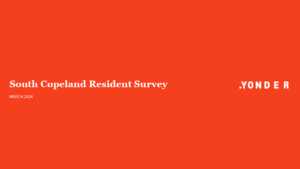Between 4 and 23 March 2024, research consultant Yonder oversaw a survey of 201 adult residents who were interviewed in person across the wards of Millom and Millom Without. An overview of the findings of this survey are presented below.
Previous community survey results are available to view within the Community Partnership website News section:
Summary
The results of the latest survey demonstrated that residents remained engaged with the subject matter. 84% of respondents stated that they were able to recall seeing or reading or hearing something about nuclear waste or geological disposal over the past year. 55% attributed their awareness to a leaflet, newsletter or postal information.
Despite high awareness of the subject matter, there remained a level of uncertainty in relation to nuclear waste management with only 27% aware of the UK’s current storage method for its most hazardous radioactive waste: at interim surface and ground-level storage facilities. A greater proportion of respondents (38%) believed it was already held in vaults deep underground in the UK, and 30% admitted that they did not know
70% were able to identify the accurate description of a GDF. 6% thought they were deep underground facilities that were currently used in the UK for the permanent disposal of nuclear waste, whilst 1% thought that they were near-to-surface sites where the UK currently buries low level waste. 22% had heard of the term ‘GDF’ but knew nothing of it, whilst 1% said they had never heard of the term.
95% claimed to be aware that a Search Area had been identified within South Copeland. Further, 84% claimed to be aware that a Community Partnership had formed locally.
When considering a GDF in the Search Area, 31% opposed it and 36% were supportive. 33% were neutral.
When asked about what kind of information they would like to receive regarding the subject matter, respondents most often requested information relating to safety (19%).
53% of the survey respondents wanted to receive information via post. 15% wanted information via the television and 13% cited in-person meetings / events.
Respondents were often unsure of who they wanted to hear from on the subject matter, though Sellafield was the most sought after.
Reaction of the Chair of South Copeland GDF Community Partnership, Ged McGrath:
“We are continuing to survey in South Copeland three times a year to make sure that we, as a Partnership, have a clear understanding of local people’s awareness, views and information needs.
“The findings help to guide our activities, ensuring that people have the information they need on geological disposal and the siting process.”
Methodological statement
Yonder is a member of the Market Research Society (MRS) and founding member of the British Polling Council and abides by its rules. The Market Research Society (MRS) is the UK professional body for research, insight and analytics. As the regulator, it promotes the highest professional standards throughout the sector via the MRS Code of Conduct.
The research programme conducted by Yonder, is not carried out by the Community Partnership, NWS, or members of the community, which maintains its impartiality.
To ensure the representativeness of the surveying, Yonder utilises random probability sampling. Random probability sampling guards against sample bias. In addition, Yonder uses the latest ONS and Census population data to ensure the sample is representative of the local area’s population (in terms of geographic balance, age and gender). With this information, quotas are employed to ensure the resident sample is representative of the relative populations of the two Search Area wards. Following fieldwork, Yonder then employs weighting to review the interviewed sample, examine any differences between quotas and the achieved interviews and correct any differences by weighting up under-represented groups and weighting down over-represented groups. This ensures the resident samples which inferences are based are representative in terms of the age and sex profile of the population in question. Utilising this approach permits justifiable inferences to be drawn from the sample to the population, at quantified levels of precision. With a sample of 201 and a 95% confidence interval, a margin of error of +/-7% is expected.
Yonder – South Copeland Resident Research Report:

